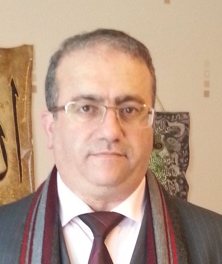
Ophthalmology & Vision Science 2021

Theme: Ophthalmology: Revolutionary Eye and Vision Research
We are delighted to announce “International Conference on Ophthalmology & Vision Research” which is scheduled to be held during October 20-21,2021, London UK to share your views and thoughts about various aspects in Ophthalmology. The theme of our conference is “Ophthalmology: Revolutionary Eye and Vision Research” which further explains about the recent trends and advancements that are taking place in the field of Vision Science along with the related topics such as Ophthalmology Disorders, Major Ophthalmologic Surgeries, Eye Care and Advancements, Cataracts, Glaucoma, Novel Advances in Vision Improvement etc. explained by experts and young researchers in respective backgrounds through their presentations on various sessions in this conference.
TRACK 1: New Advancements In Protective Eye Care
For the best eye protection from the ultraviolet (UV) radiation of sunlight, the American Academy of Ophthalmology recommends oversized or wraparound sunglasses. They should be labeled 99 percent or 100 percent UV protection, or "UV400." These lenses are effective in absorbing UV-A and UV-B radiation. The type of safety eye protection you should wear depends on the hazards in your workplace: If you are working in an area that has particles, flying objects, or dust, you must at least wear safety glasses with side protection (side shields) If you are working with chemicals, you must wear goggles.
TRACK 2: Optometry & Vision Science
Optometry and Vision Science is a healthcare profession which involves examining the eyes and applicable visual systems for defects or abnormalities as well as the medical diagnosis and management of eye disease. Traditionally, the field of optometry began with the primary focus of correcting refractive error through the use of spectacles. Vision science is an interdisciplinary study of visual systems and perception and incorporates many disciplines, including optometry, ophthalmology, molecular genetics, neuroscience and physiological optics.
- Optic and Radiations
- Optical Power of the Eye
- Stereopsis: 3D Vision
- Biophysics of vision
- Contact Lens
- Spectacle Lens
- Optic Nerve Disease
- Optical Power of the Eye
- Optical and radiation
TRACK 3: Corneal Transplantation
Cornea transplant (keratoplast) is a surgical procedure to replace part of your cornea with the corneal tissue from a donor. Your cornea is the transparent, dome-shaped surface of your eye. It's where light enters your eye and is a large part of your eye's ability to see clearly. A cornea transplant can restore vision, reduce pain, and improve the appearance of a damaged or diseased cornea. Most cornea transplant procedures are successful. But cornea transplant carries a small risk of complications, such as rejection of the donor cornea.
TRACK 4: Infectious Eye Diseases & Allergies
Eye hypersensitivities are a response to inside and outside allergens that get at you. Eye sensitivities additionally are called as Allergic conjunctivitis is a standard condition. The tissue that lines within the eyelid and outside of the eyeball is named the conjunctiva. This tissue keeps your eyelid and eyeball soggy. Hypersensitive conjunctivitis happens when this tissue gets aroused. The common symptoms of eye allergies are
- Itchiness eyes
- Swollen eyelids
- Burning feeling
- Redness
- Watery
TRACK-5: Keratoprosthesis
Keratoprosthesis is a surgical strategy where a sick cornea is supplanted with a simulated cornea. Customarily, Keratoprosthesis is prescribed after a man has had a disappointment of at least one benefactor corneal transplants. All the more as of late, a less obtrusive, non-entering counterfeit cornea has been produced which can be utilized as a part of more normal instances of corneal visual deficiency. While customary cornea transplant utilizes benefactor tissue for transplant, a counterfeit cornea is utilized as a part of the Keratoprosthesis methodology. The surgery is performed to re-establish vision in patients experiencing extremely harmed cornea because of intrinsic birth abandons, diseases, wounds and consumes. Keratoprosthesis are made of clear plastic with incredible tissue resistance and optical properties. They shift in configuration, measure and even the implantation systems may vary crosswise over various treatment focuses. The strategy is finished by ophthalmologists, frequently on an outpatient premise
TRACK 6: Optical Coherence Tomography
Optical Coherence Tomography is a noninvasive imaging technology used to obtain high resolution cross-sectional images of the retina. The layers within the retina can be differentiated and retinal thickness can be measured to aid in the early detection and diagnosis of retinal diseases and conditions. CT testing has become a standard of care for the assessment and treatment of most retinal conditions. OCT uses rays of light to measure retinal thickness. No radiation or X-rays are used in this test, an OCT scan does not hurt and it is not uncomfortable scan for a variety of reasons, including monitoring of the progress of your disease, verifying or discounting suspected swelling of the retina or checking OCT results against other results t. You may be given an OCT o determine the effectiveness of the current medication regime.
TRACK 7: Ocular Oncology
As ocular oncology is a highly specialized field of ophthalmology, there is active international collaboration between ocular oncologists. Ocular Oncology is a multidisciplinary service which includes general oncologists, pediatric oncologists, specialist nurses, clinical scientists and many others. The most common malignancies include veal and conjunctivitis melanoma, veal metastasis, intraocular and conjunctiva lymphoma and conjunctiva carcinoma. As well as the management of confirmed malignant tumors, ocular oncologists receive a large number of referrals of patients with suspected malignant tumors. Diagnosis is based on bio microscopy, ultrasonography, angiography, optical coherence tomography, auto fluorescence imaging and biopsy. The most common benign tumors include naive, choral haemangioma, Vasoproliferative tumors and retinal hemangioblastomas. Many of these lesions require treatment and/or long-term surveillance.
TRACKS 8: Refractive Surgery & Glaucoma Surgery
Refractive surgery is a method for correcting or improving your vision. There are various surgical procedures for correcting or adjusting your eye's focusing ability by reshaping the cornea, or clear, round dome at the front of your eye. Other procedures involve implanting a lens inside your eye. The most widely performed type of Refractive Surgery is LASIK (laser-assisted in situ keratomileusis), where a laser is used to reshape the cornea.. All glaucoma surgery procedures (whether laser or non-laser) are designed to accomplish one of two basic results: decrease the production of intraocular fluid (aqueous humor or increase the outflow (drainage) of this same fluid. Surgery isn’t usually the first step to treat glaucoma, but it may save your eyesight if other treatments don’t work. Surgery involves either laser treatment or making a cut in the eye to reduce the intraocular pressure.
TRACK 9: Neuro Ophthalmology
It is the solidification of neurology and ophthalmology consistently overseeing complex systemic ailments that have signs in the visual structure. Neuro Ophthalmology takes a view at the life frameworks, physiology, clinical scrambles or treatment of the afferent visual pathway, higher cortical visual structures, and the vascular tree huge to the retina and optic nerve, understudies, eye advancements and torment. Cerebral Visual Impairment (CVI) joins each and every visual broken brought on by mischief to, or falling flat of, the retrochiasmatic visual pathways without damage to the front visual pathways or any critical visual disease. Myasthenia gravis is made by a breakdown in the consistent correspondence among nerves and muscles which prompts two fold vision, hanging eyelids and unmistakable muscles inadequacy which affecting the both i.e. neuromuscular movement other than vision. Which is modified eye progression procured in starting or now and again not removed that may accomplish reduced or constrained vision. Symptomatic instruments in Neuro ophthalmology are utilized to explore and to treat the unmistakable state of Neuro-ophthalmology as Neonatal visual examination are essentially performed to screen the vicinity and improvement of Retinopathy of Prematurity. Symptomatic gadgets in Neuro-ophthalmology are used to investigate and to treat the distinctive condition of Neuro-ophthalmology as Neonatal visual examination are basically performed to screen the closeness and development of Retinopathy of Prematurity.
- Papilledema
- Optic Neuritis
- Optic Nerve Disorders
- Optic Neuropathy
TRACK 10: Clinical and Surgical Ophthalmology
Clinical Ophthalmology will improve idea into normal visual illnesses, ophthalmic surgical and laser methodology, clinical life structures and visual therapeutics. Patients with eye diseases get examined by Ophthalmologists and Optometrists. Surgical Ophthalmology is a sub-specialty of Ophthalmology, which includes surgeries like cataract surgery and laser eye surgery. Oculoplastic surgery-incorporates the organization of the eyelids, tear channels and re-gainful surgery, refractive surgery is a process for processing the vision. LASIK is the most performed kind of refractive surgery is (laser-assisted with situ keratomileusis), where cornea is reshaped using a laser. These methods are used to perform surgery commonly known as Optometry. Glaucoma surgery may be a laser or non-laser, is the procedure for achieving main results like decreasing the production of intraocular fluid (aqueous humor) or increasing the drainage of this same fluid.
TRACK 11: Pediatric Ophthalmology
A pediatric Ophthalmologist is a medical and surgical doctor (an Eye MD) who graduated from medical school and specializes in the care of children’s eyes. All Ophthalmologists have training in children’s eye disorders, but the pediatric Ophthalmologist has additional training, experience, and expertise in examining children, and has the greatest knowledge of possible conditions that affect the pediatric patient and his/her eyes. Neurologic development of vision occurs up until approximately age 12 years. Misalignment of the eyes (strabismus), uncorrected refractive error (myopia, hyperopia, and astigmatism), and asymmetry of refractive error (anisometropia) between the two eyes can negatively affect this development and cause amblyopia (“lazy eye”).
TRACK 12: Diabetic Retinopathy
Cataract in Diabetic patients may be a major explanation for visual defect in developed and developing countries. The pathological process of diabetic cataract development continues to be not absolutely understood as results of individuals with diabetes square measure statistically face her larger risk of developing cataracts. Diabetic patients the next risk of complications once phacoemulsification cataract surgery compared to no diabetics. additionally, analysis has shown that folks with kind two polygenic disease United Nations agency lower their HbA1c level by simply I Chronicles will scale back their risk of cataracts by nineteen.
- Macular
- Diabetic retinopathy
- Glucagonoma
- Gestational diabetes
- Cystic fibrosis related diabetes
- Retinopathy screening test
- Visual impairment
The global ophthalmology market is expected to increase 8.5% during the forecast period.” The global ophthalmology market is expected to reach USD 160 million by 2023 from USD 106 million in 2018. The market is recorded as $24bn in 2017, dominated by the retinal disorder drugs segment. The ophthalmic equipment market was valued at USD 47.73 Billion in 2017 and is predicted to reach USD 58.45 Billion by 2023, at a CAGR of 3.5%. Growth in this market is primarily due to the growth in the geriatric population, rising eye diseases, limited number of ophthalmologists, rising chances of eye diseases, technological advancements in ophthalmic devices, increasing government initiatives to reduce visual impairment, and increasing adoption of contact lenses and spectacles.
Ophthalmology in USA: The requirement for eye care services is increasing rapidly. The age 65+ population in USA will grow in the next 15 years. Seniors can consume as much as ten times the eye care services as younger ones; this creates an increase in the demand for ophthalmic care.
Ophthalmology in Europe: The population of Europe is expected to become older in the coming decades, the percentage of the total population age 65 years or older is expected to raise from 17% in 2008 to 23.5% in 2030.
Ophthalmology in Asia: The Asia ophthalmic drugs market is predicted to grow at an approximate CAGR of 4.00% during the period of 2018 and 2024. An existing predominance and increasing the number of eye disorders with growing geriatric population all over the Asia are the initial drivers for the market growth.
Ophthalmology Societies, USA
- Academia Ophthalmological Internationalist, USA
- American Academy of Ophthalmology, USA
- American Association for Pediatric Ophthalmology and Strabismus, USA
- American Association of Ophthalmic Oncologists and Pathologists, USA
- American Glaucoma Society, USA
- American Ophthalmological Society, USA
- American Society of Cataract and Refractive Surgery, USA
- American Society of Ocular Trauma, USA
- American Society of Ophthalmic Plastic and Reconstructive Surgery, USA
- American Society of Retina Specialists, USA
Ophthalmology Societies, Europe
- Academia Ophthalmological Belgic, Belgium
- Albanian Ophthalmological Society, Albania
- Association Latino Americana de Cirujanos de Cataract y Segment Anterior, Brazil
- Associational Italian Strabismus, Italy
- Austrian Ophthalmological Society, Austria
- Belgian Society of Cataract and Refractive Surgery, Belgium
- Berufsverband Augenarzte Deutschland’s, Germany
Ophthalmology Societies, Middle East
- Afghanistan Society of Ophthalmology, Afghanistan
- Afro-Asian Council of Ophthalmology, Egypt
- African Society of Glaucoma, Tanzania
- African Ophthalmology Council, South Africa
- Algerian Ophthalmological Society, Algeria
- Arab African Society of Retina Specialists, UAE
- Arab Board of Ophthalmology, UAE
Ophthalmology Societies, Asia
- All India Ophthalmological Society, India
- All-Russian Association of Ophthalmologists, Russia
- Asia Cornea Society, Singapore
- Asia Pacific Association of Cataract Refractive Surgeons, Singapore
- Asia Pacific Glaucoma Society, Australia
- Asia Pacific Society of Ophthalmic Plastic and Reconstructive Surgery, Japan
- Asia-Pacific Academy of Ophthalmology, China
- Asia-Pacific Society of Eye Genetics, China
- Asian Angle Closure Glaucoma Club, South Korea
- Asian Neuro-Ophthalmology Society, Japan
Young Scientist Awards at Ophthalmology & Vision Science 2021 for the best researches in Ophthalmology & Vision Science.
Meetings International is announcing Young Scientist Awards through Ophthalmology & Vision Science Conference which is scheduled at London, UK during October 20-21, 2021. This Ophthalmology & Vision Science conference focuses on Current Emerging Practices in Clinical and Experimental Ophthalmology & Vision Science.
Ophthalmology & Vision Science 2021 and upcoming conferences will recognise participants who have significantly added value to the scientific community of Medical science and provide them outstanding Young Scientist Awards. The Young Scientist Award will provide a strong professional development opportunity for young researches by meeting experts to exchange and share their experiences at our international conferences.
Eligibility:
Young Scientists, faculty members, post-doctoral fellows, PhD scholars and bright Final Year MSc and M.Phil. Candidates. Persons from Scientific Industry can also participate.
Benefits: The Young Scientist Feature is a platform to promote young researchers in their respective area by giving them a chance to present their achievements and future perspectives.
Acknowledgement as YRF Awardee
Promotion on the conference website, Young Researcher Awards and certificates
Link on the conference website
Recognition on Meetings Int. Award Page
Chances to coordinate with partners around the world
Research work can be published in the relevant journal without any publication fee
Criteria:
All presented abstracts will automatically be considered for the Award.
All the presentation will be evaluated in the conference venue
All the awards will be selected by the judges of the award category
The winners of the Young Scientist Award will receive award certificate.
The awards will be assessed as far as plan and format, intelligence, argumentation and  approach, familiarity with past work, engaging quality, message and primary concerns, parity of content visuals, and by and large impression.
Guidelines:
All submissions must be in English.
The topic must fit into scientific sessions of the conference
Each individual participant is allowed to submit maximum 2 papers
Abstract must be submitted online as per the given abstract template
Abstracts must be written in Times New Roman and font size will be 12
Abstract must contain title, name, affiliation, country, speaker’s biography, recent photograph, image and reference
Conditions of Acceptance:
To receive the award, the awardee must submit the presentation for which the award is given, for publication at the website, along with author permission. Failure to submit the PPT, and permission within the designated timeframe will result in forfeiture of award.
Award Announcements:
Official announcement of the recipients will occur after the completion of Ophthalmology & Vision Science Conference.
Ophthalmology & Vision Research 2021 helps to inform and attract new customers quickly and efficiently. The size and diversity of our advertising options, including banners, sponsored emails, article alerts or newsletters, provide clients with the very best customized marketing opportunities in science and medicine. We are one of the renowned events organizing platform with most of eminent speakers and business audience form all over the globe indexed. The advertising platform we provide you is the best chance of showcasing your products/services, and branding your company. If you are looking for a global exposure for your products and services, this is the right place for you. With over 5 million readers worldwide and nearly 3million hits a month on our website, we have engaged audience of students, research scholars, scientists, doctors, professors, pharmacists and professionals from companies across the domains. We maintain high quality and ethical standards of publication industry, which make us unique and better than the rest. Our attendees can be your upcoming customers. If you sell research materials, recycling products, chemicals or relevant equipment or services, here is the opportunity to advertise in the website that can connect you to leading experts and science specialists worldwide. Meetings International is a global leader in producing high quality conferences, meetings, workshops and symposia in all major fields of science, technology and medicine. Since its inception, Meetings International has been associated with national and international associations, corporations and high-level individuals, dedicated to host world class conferences and events. Meetings International supports broad scope research and peer review at a broad range of specialists around the world. The key strategic objective of Meetings International is to communicate science and medical research between academia, and industry. Grow your business globally and sell your research materials, pharmaceuticals, Antibodies, Clinical Reagents, Chemicals, instruments, or you are looking to recruit that next investigator. Meetings International is providing opportunity to advertise and connect with the experts and leaders across the world. Advertisement banner must be provided by the advertising company and must be in the jpg or jpeg format. The banner must be of high resolution and must not have copyright infringement. For further queries, connect our conference manager at sponsor@meetingsint.com
you can also connect us via WhatsApp: +65 3158 1626 / + 44 122980269
Google Analytics Metrics of Infectious 2021:
The visitor’s traffic is the benchmark for the success of conference and Infectious Diseases 2021 is constantly attracting viewers across the world.
According to the Google Analytics, more than 100+ monthly audiences are visiting to our conference websites for submitting abstracts; brochure downloads registration, exhibition and sponsorship queries.
Readers from the major countries including United States, Japan, United Kingdom, European Union, Asia-Pacific and Middle East visit our conference domain to participate and present their latest research.
Google Analytics Metrics of Meetings International:
437,380 + Users
1,606,987 + Page views
644,430 Sessions at the rate of 1.47 per user
Meetings International has so far received 644,430 Sessions which confirm the outstanding pool of new users and visitors. Meetings International works on Open Access publishing model, hence they are the best choice for the scholars and authors worldwide. We understand the importance of timely communication and our efficient and quick review process avoids unnecessary delays in the production, publication and circulation of the published material worldwide with in no time while enhancing the visibility of the authors and conferring credibility to scholars and readers. The promotion of the individual author contributions is taken care of and hence the authors enjoy the reputation among global audience. Meetings International values the contributions by the authors and takes adequate measures in propagating and promoting their outcomes by permanently archiving as well.
Meetings International has always been at the forefront to support and encourage the scientific and techno researchers to march forward with their research work. International Conference on Ophthamology & Vision Research offers various awards as reorganization to exceptional researcher and their research work. We invite all enthusiastic researchers from all around the world join us for the . International Conference on in Ophthamology & Vision Research London,UK on October 20,21 2021.
Eminent Keynote Speaker Award:
Ophthamology & Vision Research 2021 will confer the Model Keynote Speaker Award to the researchers who have spent a considerable time of their academic life towards the research related to conference topic. Key note speaker award is for the researchers/speakers who have done all the hard work behind the scene. It will be a small clap for their dedication and hard work.
Outstanding Speaker Award:
Ophthamology & Vision Research 2021 will best model speaker award to those researchers who have made significant contribution towards the conference topic during their research period as well as presented the research topic in an impressive way in the oral presentation during the summit. It will be an apt appreciation from the Jury as well as from the delegates. The award they receive will motivate them to march forward with the research work.
Model Organizing Committee Member Award:
Ophthamology & Vision Research 2021 will take this opportunity to facilitate eminent experts from this field with the model Organizing Committee Member award for their phenomenal contribution towards the society through their academic research. This will be a trivial but significant reorganization of their dedication and discipline.
Promising Young Researcher Award:
The motive of this Award during the Ophthamology & Vision Research 2021 is to appreciate research work of the budding young researcher who is continuing their research work to create a better society. The award will provide them a tremendous amount of encouragement to keep moving forward.
Educative Poster Award:
The educative poster award for the Ophthamology & Vision Research 2021 will be endorsement for those who wishes to display their research paper through a poster and will act as a guiding force those researchers. The award will be presented to the most informative and educative research poster.
Criteria:
All presented abstracts will automatically be considered for the Award.
All the presentation will be evaluated in the conference venue.
All the awards will be selected by the judges of the award category.
The winners will be formally announced during the closing ceremony.
The winners of the Poster Award will receive award certificate.
The awards will be assessed as far as plan and format, intelligence, argumentation and approach, familiarity with past work, engaging quality, message and primary concerns, parity of content visuals, and by and large impression.
Guidelines:
All submissions must be in English.
The topic must fit into scientific sessions of the conference.
Each individual participant is allowed to submit maximum 2 papers.
Abstract must be submitted online as per the given abstract template.
Abstracts must be written in Times New Roman and font size will be 12.
Abstract must contain title, name, affiliation, country, speaker’s biography, recent photograph, image and reference.
Each poster should be approximately 1x1 M long. The title, contents and the author’s information should be clearly visible from a distance of 1-2 feet.
- New advancements in Protective Eye Care
- Optometry & Vision Science
- Corneal transplantation
- Infectious Eye Diseases & Allergies
- Keratoprosthesis
- Optical Coherence Tomography
- Ocular Oncology
- Refractive Surgery & Glaucoma surgery
- Neuro Ophthalmology
- Clinical and Surgical Ophthalmology
- Pediatric Ophthalmology
- Diabetic Retinopathy
- International Journal of Ophthalmic Pathology
























































































































